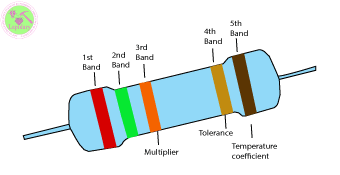1) Find the resistance value of a resistor using its
color code
To find the resistance value of a resistor from its color code, follow these steps (3 band 4 band system):
- Identify the color of the first band, which represents the first digit of the resistance value.
- Identify the color of the second band, third band which represents the second/third digit of the resistance value.
- Identify the color of the third band , which represents the multiplier or number of zeros to be added to the resistance value.
- Calculate the resistance value by combining the first two digits and multiplying the result by the multiplier.
The table below shows the color codes and corresponding values for the first three bands:
| Color | Digit 1 | Digit 2 | Multiplier |
|---|---|---|---|
| Black | 0 | 0 | 1 |
| Brown | 1 | 1 | 10 |
| Red | 2 | 2 | 100 |
| Orange | 3 | 3 | 1,000 |
| Yellow | 4 | 4 | 10,000 |
| Green | 5 | 5 | 100,000 |
| Blue | 6 | 6 | 1,000,000 |
| Violet | 7 | 7 | 10,000,000 |
| Gray | 8 | 8 | 100,000,000 |
| White | 9 | 9 | 1,000,000,000 |
For example, if the color code of a resistor is brown-black-orange, the first two digits are 1 and 0, respectively, and the multiplier is 1,000. Therefore, the resistance value of the resistor is 10 x 1,000 = 10,000 ohms, or 10 kilohms.
It is also important to note that some resistors have a fourth band that represents the tolerance of the resistor, which indicates the maximum amount of deviation from the nominal value. The tolerance band is usually silver, gold, or brown and is located at the end of the color code.
2) Resistance value Calculator from Colour Code
1. Select 1st colours from drop down list as in the resistance
2. Select 2nd and so on ....
3. Value will be displayed in both Ohms and Kilo Ohms in respective column
4. Tolerance will be shown on tolerance columne
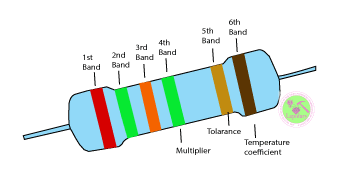
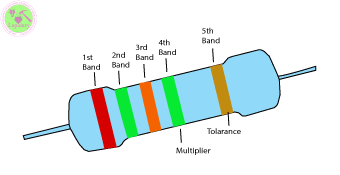
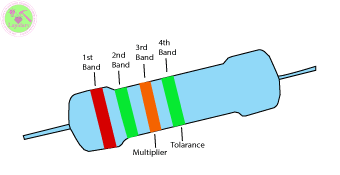
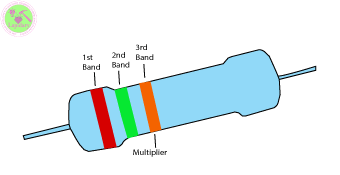
3)Colour Code
Color Code Chart (6-Band)
The resistance color code uses a series of colored bands to represent the value, tolerance, and temperature coefficient of a resistor. The chart below shows the colors and corresponding values for the four bands used in the EIA-96 standard:
Band 1 – 1st digit: Black (0), Brown (1), Red (2), Orange (3), Yellow (4), Green (5), Blue (6), Violet (7), Gray (8), White (9).
Band 2 – 2nd digit: Same as band 1.
Band 3 – 2nd digit: Same as band 1.
Band 4 – Multiplier: Black (x1), Brown (x10), Red (x100), Orange (x1,000), Yellow (x10,000), Green (x100,000), Blue (x1,000,000), Violet (x10,000,000), Gray (x100,000,000), White (x1,000,000,000), Gold (x0.1), Silver (x0.01).
Band 5 – Tolerance: Brown (+/-1%), Red (+/-2%), Green (+/-0.5%), Blue (+/-0.25%), Violet (+/-0.1%), Gray (+/-0.05%), Gold (+/-5%), Silver (+/-10%).
Some resistors may also have a fifth band that represents the temperature coefficient, which indicates how much the resistance value changes with temperature. The temperature coefficient is represented by a colored band as follows:
Band 6 – Temperature Coefficient: Brown (+/-100 ppm/°C), Red (+/-50 ppm/°C), Orange (+/-15 ppm/°C), Yellow (+/-25 ppm/°C), Blue (+/-10 ppm/°C).
Using the Color Code
To read the value of a resistor using the color code, start by identifying the first two bands, which represent the first and second digits of the resistance value. Then, find the third band, which represents the multiplier. Multiply the value of the first two bands by the multiplier to get the resistance value in ohms. Finally, use the fourth band to determine the tolerance of the resistor.
For example, a resistor with the color bands Brown-Black-Red-Gold represents a resistance value of 1,000 ohms (Brown=1, Black=0, Red=x100) with a tolerance of +/-5% (Gold).
Conclusion
The resistance color code is an essential tool for electronic engineers, hobbyists, and manufacturers who work with resistors in electronic circuits. By using a series of colored bands, the code provides a standardized and reliable

—-
!!!! Both are 5 Color Band, But the values are different. Always there will be more gap
with tolerance band
